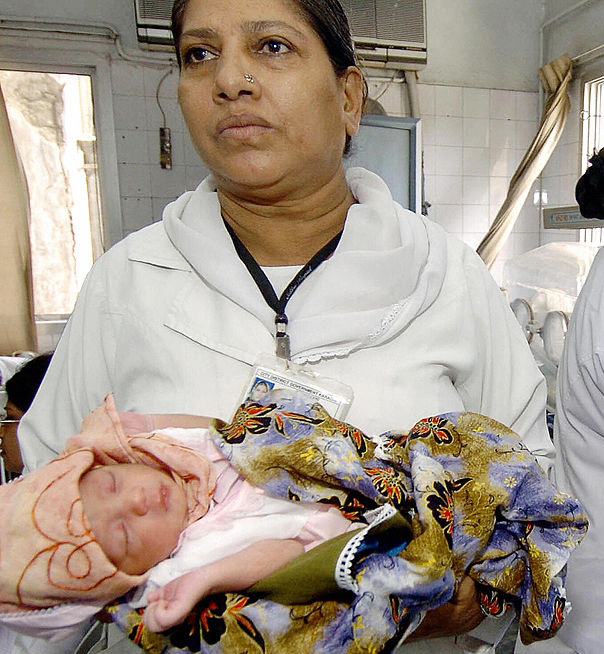In the early hours of October 17, Sameera Bibi went into labour. Her husband, a construction worker, rushed her in a rickshaw to the Tehsil Headquarter Hospital in Raiwind, on the outskirts of Lahore. On the way there, the couple were anxious and excited. There was little to worry about. The doctors had promised a successful and safe delivery. But on arriving at the hospital, panic set in. At 6 AM in the morning, none of the obstetricians were available. Neither were there any ambulances that could take Bibi to another hospital. Eventually, the woman, doubled over in pain, was sent to sit outside on the pavement, where she was forced to deliver her child, unattended and with only her husband by her side.
Four days earlier. In Faisalabad, a woman gave birth to a baby boy inside a Rescue 1122 ambulance. She told reporters that the staff at the Tandlianwala Tehsil Headquarter Hospital turned her away. Normal delivery services, they told her, were not offered on Saturdays.

In Pakistan, maternity services often fail women from low-income groups, who experience the worse care during pregnancy and at the time of delivery. State-run hospitals are often overcrowded or lacking in basic healthcare facilities. Last week, at the Polyclinic Hospital in Islamabad, three pregnant women were seen sharing one, single bed.
Overpopulated labour rooms, and the shortage of hands, also force women to opt instead for deliveries at home, with or without skilled midwives. “Ten years ago, I was with my sister at a government hospital for the birth of her first child,” Razia, the mother of four in Rawalpindi, told Geo.tv “It was terrible, the experience. At that point, I promised myself I would deliver all my children at home, no matter what.”
Of the 4.4 million mothers-to-be, only half are delivered at health facilities, according to the World Health Organization. More and more women prefer to stay at home and would only seek out a professional during times of complications. This is a problem. Prenatal care is important to saving the life of both the mother and the child. In 2006, 239 women died per 100,000 live births. Since then, the survival rate has improved. In 2016, 178 women died giving birth per 100,000, according to the World Bank. Yet the overall picture remains grim.
Take the UNICEF study, for example, that calculates that out of 10 women only five in Pakistan’s rural areas visit a trained birth attendant. While in urban areas, nine out of 10 women seek out a doctor during their pregnancy. In Baluchistan, fewer than two in 10 women give birth at health centers.
In the district of Rajanpur (Punjab), Tharparkar (Sindh) and Sherani (Balochistan) only one in 10 mothers have professional assistance.
But even if more Pakistani women were ready to seek obstetric care, they are likely to be turned away. Dr Humaira Sikander, a gynaecologist at the Poly Clinic Hospital in Islamabad, says, “We provide antenatal care to over 300 pregnant women every day, whereas we only have the capacity for 130 to 150 women daily.”
One solution to helping the under-resourced health facilities could be by improving Basic Health Units around the country that are required to provide minimal and primary healthcare services in rural areas. But in most cases, these units are either ill-equipped or located at far distances. Women, adds Dr. Sikander, often bypass the BHUs and come directly to the hospitals for even minor complaints.
When it comes to maternal and childcare, the government has introduced a raft of initiatives. In 1994, the National Program for Family Planning and Primary Healthcare hired 100,000 lady health workers at a salary of Rs 10,000 to look after 1,000 mothers each. It has been almost two decades since. None of the health workers have been regularized. Most are still being paid the same amount they received in the 90s. “We have protested several times in front of the parliament,” explains Ruksana Anwar, the president of the Lady Health Workers Association in Punjab. During the last tenure of the Pakistan People’s Party, the Supreme Court took notice of their complaints and instructed the government to regularise their services. Little has been done since.
Then there are other challenges to the prenatal services: lack of professionals. Pakistan only has 1,795 gynaecologists, mostly concentrated in urban areas, and 215,806 nurses and midwives to cater to the 13,000 babies born each day. The federal government plans to launch a Human Resource Strategy across all four provinces that would include hiring and training new medical staff. But when and how? No one can say.


